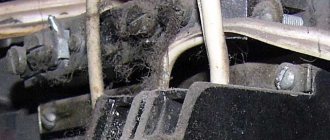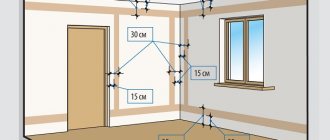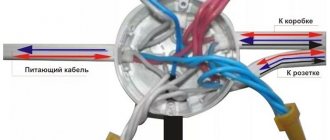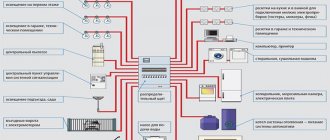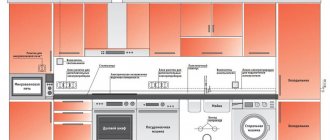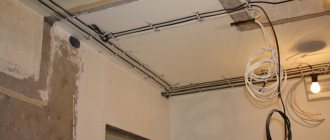Installation of electrical wiring is a mandatory stage in equipping workshops, buildings, houses and apartments with “life support systems”. At the same time, there was a constant increase in power consumption.
Before installing electrical wiring, you need to decide on the following key points.
Decide on the type of input - single-phase (220V) or three-phase (380V).
Group lighting lines can be single-, two- and three-phase depending on their length and the number of connected luminaires. At the same time, the use of fuses and single-pole circuit breakers is prohibited in two- and three-phase group lines. Single-phase group lines should be three-wire, two-phase - four-wire and three-phase - five-wire with separate N and PE conductors. When using busbars in the TN-C system, it is allowed to combine N and PE conductors - PEN bus, while the cross-section of the PEN conductor must be at least 10 mm SP 31-110-2003 Design and installation of electrical installations of residential and public buildings using copper. It is prohibited to combine N and PE conductors of different group lines.
Three-phase input of electrical wiring is advisable only if the premises have a workshop or workshop where three-phase asynchronous motors or similar equipment operate.
Next, you need to develop a wiring diagram. This is a detailed marking on the plan of an apartment or house of the locations of sockets, switches, main current consumers and, most importantly, the lines going to them from the distribution panel. In case of complex work, a technological map is drawn up with a detailed description of the procedure.
It is imperative to calculate the total power of the maximum one-time energy consumption of all devices in a given room, taking into account the maximum consumers who will be allowed to work simultaneously.
Usually this is a refrigerator, lighting systems, computer and router, TV, heating systems (if electric), split system, washing machine.
On the wiring diagram it is necessary to divide sections according to load level. In order to save on cable costs, a copper cable with a cross-section of 1.5 mm is used for the weakest consumers - lighting lamps, sockets for charging low-power electronics (players, phones), for the main group (almost all household appliances) - 2.5 mm, for the most powerful - electric stove - copper with a cross section of 4 mm is used.
The input cable must have a cross-section of at least 6 mm for each conductor.
Table 1. Approximate electricity consumption of household appliances
| Table of approximate electricity consumption by household appliances | |
| Electric oven -17221 W | Humidifier - 75W |
| Central air conditioner -5000W | Incandescent lamp - 60W |
| Stereo system -60W | Aquarium - 30W |
| Laptop -50W | Hairdryer -1530W |
| Monitor -150W | Coffee maker - 1500W |
| Printer -45W | Microwave oven -1500W |
| Digital video recorder-33W | Iron -1100W |
| Dryer for clothes and clothes - 3400W | Room air conditioner -1000W |
| Electric oven -2300W | VCR -11W |
| Electric kitchen stove -1000W | Clock radio - 10W |
| Vacuum cleaner -650W | Plasma TV -339W |
| Water heater -479W | Blendar-300W |
| Washing machine -425W | Freezer -273W |
| Air dehumidifier -350W | LCD TV -360W |
| Portable fan -100W | Game console -195W |
| Ceiling fan -75W | Refrigerator -188W |
Table 2. Calculation of cable cross-section
To avoid danger when installing electrical wiring, you need to correctly calculate the cross-sectional area of the wires, because the resistance depends on it. The greater the resistance, the more the wires will heat up. An important role is played by the correct selection of cable materials, connection of wires, choice of installation location, and insulating materials. It is necessary to correctly calculate the load and select protective devices, do not forget about grounding.
An error can lead to a short circuit, and as a result, a fire occurs. To prevent this from happening, you need to use rules and regulations. If the building was erected without complying with them, the insurance company will not pay insurance in the event of an accident. Material losses can be quite significant, not counting human lives, the loss of which is irreparable.
In order to secure the wiring, you need to install a fire-fighting device RCD (residual current device) and set certain values on it. For a common line in a house, the leakage current is set to 100 mA, and for individual lines at least 10 mA. When these indicators increase, the RCD must de-energize the room.
At the same time, electrical wiring should be carried out only with those cables that are safe and permitted in accordance with GOST. The most popular option for use is the VVG cable and its modifications. According to the requirements of the PUE, three-core cables with copper conductors must be used in industrial and residential buildings. Aluminum cannot be used. Aluminum wires carry electricity to the house, and bolted terminal blocks or an adapter washer are used to connect the two metals. Direct contact is prohibited. An important step is to choose the type of installation - open (in cable ducts) or hidden (inside the walls - walled in plaster, hidden behind panels).
According to modern standards for installing electrical wiring, each group of consumers - stove, main household appliances, lighting - is equipped with a separate circuit breaker for protection against short circuits, and a separate RCD - residual current device - to protect people living in the house from electric shock.
Once you have decided on the diagram and type of new electrical wiring, you can begin installing it. In this case, first of all, the electrical wiring in the building is fully installed, and only in the second place it is connected to the common panel and the electric meter.
Requirements
The main requirement for electrical wiring is compliance with safety requirements and compliance with the tasks that will be assigned to it.
The basic rules for installing electrical wiring are contained in the main document for electricians - PUE (Rules for Electrical Installations). In particular, Chapter 2.1 defines the rules, regulations and requirements for indoor and outdoor electrical wiring. Compliance with the requirements of regulatory documents is mandatory, since these standards were derived through verified calculations and confirmed experimentally.
According to the latest requirements, residential electrical wiring must adhere to the TN-CS power supply system standard or, in extreme cases, TT. The systems imply a different approach to grounding and connecting the neutral conductor. This is necessary to prevent electric shock if you unintentionally touch the body of the device, which has a short circuit to the body as a result of a malfunction. In addition to grounding, the level of safety is additionally affected by the installation of protective equipment that automatically interrupts the power supply when leakage currents occur.
The PUE specifies permissible current values for wires of various cross sections, copper or aluminum, as well as methods of laying, fastening, connections and branches.
Installation of hidden electrical wiring behind wall panels
Wall thermal panels are not uncommon in modern housing construction. How to lay wires under them so as not to damage the surface? It is recommended to distribute the main wiring diagram under the panels in advance. The process is similar to laying cables in walls, but without gating.
Follow these recommendations from professional builders:
- Pipes are made of non-combustible materials;
- For powerful electrical appliances, special mounting boxes are used;
- It is strictly forbidden to lay wires or cables across them.
Wall thermal insulation panels are mounted on a metal profile. Holes for laying the cable are pre-drilled in the profile. Perforated metal profiles are also sold. Corrugated pipes are used to pull wires - without such protection, the wiring insulation can be damaged by the sharp edges of the profile.
Distinctive features of modern electrical wiring
At the end of the 20th century there was a breakthrough in modern household technologies. In addition to televisions, other devices began to be used inside homes:
- Wireless connection.
- Powerful household appliances.
- Video surveillance and security systems.
- Computers.
Therefore, work with the installation of electrical networks has become more complicated. The principles of operation and arrangement remain the same. Even the first stage - design - causes difficulties. It is necessary to know the locations of household appliances and the power they absorb. The lighting system for each room is thought out at the same stage.
Now they use not only power, but also low-current systems. These are wires for TVs, telephones, and computers. This also includes acoustic and security equipment. Power and low-current systems are not separated. The power source for the devices is a classic 220 V network.
The number of devices and devices with simultaneous operation is changing upward. Previously, one chandelier was enough, now local or a system of spotlights is added to the overhead light. The total power consumed by the devices also increases.
Wall cutting and wire laying
You can make grooves in the walls using simple hand tools - a hammer and a chisel - but it is much faster and easier to use a hammer drill or grinder.
Working with a grinder:
Two parallel recesses are cut in the wall along the wire laying line, and the insides are knocked out with a hammer drill with a flat lance. The groove is made in width depending on the thickness of the wire or cable run. The depth of the groove should be such that all wires can be plastered. The grinder is used when you need to make grooves in concrete walls.
Working with a hammer drill:
It is easier to punch brick walls directly with a hammer drill. Without using a grinder. Brick walls are much softer and the work will go much faster. There will also be much less dust.
The wire is laid in the recesses so that at least 5 mm remains to the outer surface. This will be the layer of plaster that will cover the groove.
Installation of wires in corrugated pipes
There is a special mechanism for pulling wires through the pipe. At home, you can use a cable of suitable diameter. According to SNiP, 30% of the pipe volume should remain free.
It is strictly forbidden to string low-current wires and power cables through the same pipe. It is allowed to lay lines parallel to each other. But without intersections, twisting and overlaps.
The angle of rotation of the corrugated pipe must be less than 90˚, otherwise difficulties will arise with pulling the cable.
Necessary materials and tools for work
High-quality electrical wiring must meet the requirements of SNiP and safety standards. To carry out such wiring, you will need consumables and tools:
- electric meter;
- residual current device (RCD) for conducting currents under normal operating conditions or when leakage currents occur;
- power, low-current, lighting cable;
- branch boxes;
- terminal blocks (preferably screwless);
- sockets and switches;
- socket boxes;
- open type electrical wiring box;
- a mixture of alabaster for installing the cable inside the groove;
- glue;
- screws and self-tapping screws;
- baseboards;
- electrical insulating cardboard;
- tin strips for fastening.
Tools you will need: wall chaser, chisel, hammer, scissors for cutting cables. To lay the cable inside walls or boxes, you will need a spatula and an emery float. You will also need pliers, a screwdriver, a measuring tape and a knife.
Protective equipment
How to lay electrical wiring: rules and definitions
To prevent the consequences of damage to electrical devices and wiring, power circuits are equipped with several types of protective equipment:
- Circuit breakers;
- Residual current devices - RCD.
The listed devices pursue different purposes and cannot replace each other, but only complement them.
Circuit breaker
Automatic circuit breakers are designed for emergency opening of circuits in the event of a short circuit or an unforeseen increase in load. The circuit breakers must correspond in current to the rated load, which involves switching on devices installed in the protected circuit.
Residual current devices respond to leakage currents, which cause circuit breakers to trip, but can lead to the formation of a life-threatening potential on the device body.
RCD
New wiring: permit, contract, necessary documents
New wiring in an apartment with your own hands should begin with a project. This is a plan of each room in the apartment with marks of the places where the electrical wiring will be located. The lighting plan and outlet layout are two separate electrical wiring lines, so they need to be done separately from each other.
The power supply project is drawn up by a specialist or organization with the right to carry out such work. The designer draws up a plan in accordance with the requirements of the PUE, so there will be no problems when putting electrical wiring into operation. At the same time, he takes into account the customer’s wishes regarding the placement of sockets and switches, taking into account the number of connected household appliances.
Before installing new electrical wiring, you must address the issue of obtaining technical specifications and allocating the required power. This is especially important before building a new home.
To obtain electrification, you need to go through several stages:
- Contact the HOA or management company to obtain a certificate for the allocated power and a certificate showing the apartment’s power supply diagram.
- Contact a company that will draw up a project for the electrical supply of the apartment and conclude an agreement.
- Coordination of the project with the maintenance service of the house, then with Energonadzor.
- Installation of electrical wiring.
- Invitation of a licensed electrical laboratory to conduct tests of the electrical network. Based on the test results, it issues a Technical Report with protocols for testing and measuring equipment.
- Drawing up an application to Energonadzor with attached documents with the results of network testing for acceptance of new wiring. Coordination of the quality of installation and the correctness of its implementation by the Energonadzor inspector. If the work is completed without any violations, he issues a Certificate of Permission to Operate the Electrical Installation.
Having received the certificate of approval, you need to contact the house maintenance service to connect to the electrical network according to a permanent scheme.
Environmental influence
The main environmental factors affecting the durability and performance of the cable route and, directly, the power main itself include: - humidity (including precipitation in the form of dew, rain, snow); — the presence of caustic vapors or gases (acidic and alkaline); — increased ambient temperature; — the presence in the ambient air of flammable or explosive components in the form of gas, dust, aerosols, which can detonate when sparking.
All of the above factors can have a destructive effect, both on the cables and electrical wires themselves, and on the cable trays and ducts supporting them.
Destruction of the integrity or extreme deformations of the cable-carrying line, as well as destruction of the insulation of cables and wires, can disable the entire route and lead to accidents, in particular, electric shock to people.
The main measure of protection for a cable or wire line is mechanical. That is, current-carrying systems are placed in metal boxes, on cable trays or hidden in pipes. For special operating conditions, special cable trays and boxes have been developed: fire-resistant, earthquake-resistant, sealed, etc.
The rules for laying cables and wires, in general, and in metal boxes and trays, in particular, are dictated by the PUE - “Rules for the Construction of Electrical Installations”.
Creating a Wiring Diagram
In new apartment buildings, the general building electrical network is connected only to the apartment. The entire layout of the electrical network inside the apartment is already carried out by the owner, depending on the developed plan for the arrangement of furniture and electrical appliances. This is convenient, because owners of apartments with a ready-made network will have to partially or completely dismantle the old one in order to change it.
You can draw up a wiring diagram for your apartment and carry out its installation yourself, or you can entrust this task to specialists. The second option requires a fairly expensive investment, but it is worth remembering that working with electricity is life-threatening.
If you do not have certain skills, then it is better to entrust the installation to specialist electricians, and you can draw up the wiring diagram yourself.
The diagram can be made on a small piece of paper, but be sure to apply all the elements in accordance with generally accepted designations. Any installation begins with the development of a diagram of the future electrical wiring.
Connecting wires
Wire connections in distribution blocks are made using:
- Twist;
- Bolted connections;
- Soldering;
- Special tips;
- Spring terminals.
Soldering is considered the most reliable, but its implementation is complicated by the fact that operating an electric soldering iron requires electricity, which may not yet be available at the repair stage. In this case, gas soldering irons are used.
Simple twisting of wires is also widespread. This is a completely reliable option, provided that the connection point is carefully insulated (this also applies to solder joints).
Important! Under no circumstances should aluminum and copper wires be connected by twisting. With such a connection, a galvanic couple is formed, as a result of which the surface of the conductors is covered with a layer of oxides, which leads to loss of contact in the connection.
Nowadays, WAGO type terminals have become very popular. Such terminals have special spring elements that securely fix the wires and provide reliable electrical contact. In terms of speed and ease of work, this is the most convenient option. The terminals are designed to work with certain currents, which must be taken into account when purchasing them. Power terminals are large in size.
WAGO terminals
Important! The high demand and high cost of WAGO terminals have led to the fact that the market is saturated with counterfeit products, which in appearance are practically no different from the original ones, but have low electrical parameters and reliability. This is the reason for a number of negative reviews and mistrust on the part of many electricians.
Connection using insulated ferrules has low material costs and is also widely used.
Why do you need a wiring diagram?
It turns out that installing modern electrical wiring in an apartment is a real art, which only a professional electrician can handle.
If you do not want to constantly change the decoration of the walls in order to mask cables that appear here and there, we recommend that before renovating an apartment or building a house, draw up a drawing indicating all significant objects related to electricity: sockets, switches, an electrical panel with an RCD, lighting fixtures.
A sample diagram that a homeowner can sketch. Attention is paid to marking the locations of all electrical points, from the electrical panel to the sockets. Based on the requirements or wishes of the home owner, the electrician draws up a schematic diagram of the electrical wiring in the apartment. His task is to divide the cables into groups in order to properly distribute the load, think through the control and protection system, and ultimately do everything to guarantee safety and comfort.
What must be taken into account when drawing up a diagram, drawing, work plan necessary for proper installation of electrical wiring?
Let's consider the electrical network from the point of view of its component parts:
- Automatic protection devices installed in the electrical panel. The functioning of all home equipment and the safety of users depend on their quality and proper installation.
- Cables and wires with the correct cross-section and good insulation.
- Sockets and switches with high-quality contacts and safe housings.
In private houses, a mandatory element is an input circuit breaker and a power cable from it to the switchboard. Using a circuit breaker, the power consumption is regulated and, if necessary, all electricity in the house is turned off.
Approximate wiring diagram in a private house. The main attention should be paid to the distribution of power across circuit breakers and the protection of each dedicated line. The electricity meter is usually installed at the entrance, after the input circuit breaker.
Beginning of work
Before installing wiring in an apartment, it is necessary to draw up a schematic wiring plan with the location of all points: sockets, switches, junction boxes, lighting fixtures.
To draw up a wiring diagram in an apartment, you need a large-scale plan of the premises, since in this case it is easier to calculate the required length of the electrical cable. When drawing a diagram, you need to adhere to generally accepted standards for designating devices so that the drawing is understandable to any person performing the work.
The placement of sockets and switches may have several standards. According to one of them, sockets are placed at a height of 0.3-1 m from the floor level, and switches at a height of 0.8-1.5 m. These values are not critical and are selected for ease of use. One of the factors in choosing a location is the arrangement of furniture.
In any standard, it is necessary to adhere to the requirements of the PUE, according to which horizontally laid wires in walls must depart from the ceiling at a distance of 150-200 mm, and the distances from door and window openings must be at least 100 mm.
Wiring plan
The location of sockets and switches in bathrooms is specified separately. The distance from the switching equipment to conductive elements (sewage and water supply pipes) must be at least 600 mm and at least 130 cm from the floor level.
Dividing electrical wiring into groups (lines)
It is much easier to manage and control an electrical network if it is divided into several lines. In the event of a malfunction or emergency, you can turn off one group, while the rest will function as usual.
Option for dividing into 4 groups:
- Group 1 – powerful household appliances
- Group 2 – kitchen line
- Group 3 – bathroom and toilet
- Group 4 – lighting system
Below we will talk about each electric group in more detail.
Stationary household appliances
Large household appliances are usually located in the kitchen or bathroom area. Layout of sockets in the kitchen. Rules: it is prohibited to place sockets directly behind the dishwasher and washing machine; It is better to use waterproof models.
A separate connection for the kitchen area is necessary for repairs. If one of the devices breaks down, a replacement will be required. In order not to turn off the electricity in the entire apartment, it is enough to turn off one protection device responsible for stationary equipment. Unfortunately, even expensive household appliances break down from time to time. Repairs sometimes take several hours. A separate electrical group will allow you to maintain a comfortable stay in the kitchen and other rooms.
What prevents you from simply disconnecting a broken device from the network by pulling the plug from the socket? The fact is that built-in equipment has connection points to the electrical network in hard-to-reach places. In addition, the malfunction may occur not in the device itself, but in the wiring disguised in the wall. In this case, it is much easier to move the circuit breaker lever.
Dedicated line for the kitchen
The kitchen line is traditionally the busiest. Approximately 5-6 units are constantly connected to the network, even when not in use. This applies to the refrigerator, oven, hob, dishwasher, hood, microwave, toaster. Many people use a kitchen electric grill, meat grinder, bread maker, multicooker, etc.
Electrical wiring diagram for the kitchen, divided into 4 groups. For powerful household equipment, separate circuit breakers are installed in the distribution board. In this case, a separate powerful electrical cable will simply make it possible to use several devices simultaneously.
If lighting devices or a water heater are also “hanging” on the common wiring, then when the next device is turned on, the network simply cannot withstand it and an automatic shutdown will occur. A detailed analysis of diagrams and options for the location of sockets in the kitchen is given in the article, which we recommend that you read.
One or more lighting groups?
Considering the number of lighting fixtures in each room, you can make one or several lines. If there is one six-arm chandelier in the hall, and in the bedroom there is low-power overhead lighting and two chandeliers, then all the devices can be combined into one line.
However, if the living room resembles a disco hall - with chandeliers, spotlights, ceiling and wall lighting - then a separate group should be organized only for it.
Wiring diagram for 220 V spotlights or halogen lamps for one room, for example, a kitchen, children's room or hallway. If, in addition to lamps, the network of one room includes transformers or power supplies, then it is also recommended to connect it to a separate protection device.
Rooms with high humidity
Increased requirements apply to electrical appliances and cables in the bathroom, since the close proximity of water is a risk. In order for the electrical network to be safe and functional, a number of rules must be taken into account when drawing up the diagram and installing the wiring:
- The distribution box should be installed outside the bathroom - in the corridor, hall or hallway
- For each device that is used in the bathroom (washing machine, mirror lamps, hair dryer or electric razor), it is necessary to allocate a separate socket
- Regardless of the size of the bathroom, the switch is always installed on the outside. The best place is near the front door
- It is recommended to lay the electrical cable at the top of the wall, right under the ceiling, placing the lines parallel to the floor and using an insulating sleeve
The requirements also apply to the choice of fittings that will be used regularly - sockets and switches. Suppose the degree of protection of sockets should be at least IP 44, and it is even better to purchase special devices with a splash-proof cover.
It is recommended to abandon 220 V lamps in favor of 12 V analogues.
A three-core copper wire is quite suitable for installing sockets in a bathroom, but you should pay attention to the cross-section: for connecting ordinary appliances it must be at least 2.5 mm², for powerful electrical equipment - 4 mm². The domestic version is VVGng.
Cable selection
The main materials used for installing electrical wiring, logically, include cable. You cannot neglect the correct selection of cables for electrical wiring, since at best this will only lead to an increase in the cost of installing the system, and at worst - to wiring failure, breakdown, electric shock or fire.
There is a huge variety of power cables on the market - and this is not counting cables for low-current systems - alarms, video surveillance, communication systems. In order not to make a mistake with the choice, we will make a reservation right away: for installing household electrical wiring, only the following types of power cables can be used:
- VVG;
- NYM;
- PVA (limited - for lighting only).
It is strictly prohibited to use power wires for other purposes, for example, communication cables.
VVG cable is a single-core copper cable specially designed for indoor installation.
It can be used for installation of electrical wiring in networks with voltages up to 1000 V. Inside the cable there are 2 or 3 copper conductors, each with a cross-section from 1.5 to 10 mm (depending on the type of cable). Each core has individual insulation, all three are additionally protected by a common one. Insulation material is vinyl.
Figure 1. Modification of insulated cables
For systems with grounding (mandatory requirement), a three-core cable is used. Marking - VVG 3x1.5 (3 cores with a cross-section of 1.5 mm) - for lighting, VVG 3x2.5 - installation of wiring for household appliances, VVG 3x4 - installation of a line for an electric stove, VVG 3x6 (or 3x10) - input of electrical wiring into the house. A vein in blue insulation is always zero, in yellow-green insulation it is earth, in brown, black or white it is a phase.
NYM cable is a German analogue of VVG, characterized by an additional layer of intermediate insulation for fire protection. Its advantage is the possibility of installation without additional insulation in rooms with high humidity, as well as ease of cutting.
The disadvantage is the higher price than VVG, as well as the low resistance to sunlight inherent in the PVC from which its insulation is made. This cable is recommended for installation in cable ducts or grooves, but not in the ground or outdoors. The marking is completely similar to VVG.
PVS is, strictly speaking, not a cable, but a wire. It consists of three stranded conductors, and is much more flexible than VVG or NYM. But the current load that flexible multi-cores can withstand is significantly lower than single-core.
PVA with a cross section of 1.5 mm can only be used for installing ceiling lighting, and you cannot do without crimping the ends of the wires with ferrules. It cannot be used for other electrical wiring elements.
The main methods of installing electrical wiring are: open, also called external or external, and closed - internal, as well as combined. The first installation method is simpler - it involves laying cables outside the walls, in cable channels.
Regardless of the installation method, the rules and regulations for the placement of electrical wiring state:
- to minimize problems during repair work, the wires should lie strictly vertical or horizontal;
- horizontal sections should be placed at a distance of 150 mm from the ceiling (in some cases 200 mm is allowed);
- vertical sections should not be in close proximity to corners and openings of doors and windows - the minimum value is 100 mm;
- the distance from gas pipes is at least 0.4 meters;
- The wires themselves should not touch each other.
You also need to pay attention to the difference in the placement of group electrical networks depending on the type of room. This can be found out based on Table 14.2 of SNiP 31-110-2003; GOST R 50571.5.52-2011 also describes the installation of electrical wiring. Referring to Table A.52.2 of this GOST, you can find out the method of installing electrical wiring depending on its location.
Electrical wiring methods
There are two ways to lay the wire. This is in an open way and in a hidden way. The open method is on top of the plaster, and the hidden method is inside the plaster.
The entire electrical wiring route must run vertically and horizontally. It is prohibited to lay the route diagonally.
Hidden way of laying electrical wiring
This method is more relevant and is mostly used only, that is, we are talking about hidden wiring to sockets, switches, wall lamps (if provided), apartment panels and distribution boxes. For hidden wiring, there are different types of installation: on the floor, on the wall and on the ceiling.
A wire is laid along the floor in a special corrugation for pouring the floor screed. If there is already a filling of the solution, then grooves are made for the corrugation with the wire, with access to the wall to the distribution boxes, then to the sockets and switches.
If you decide to lay electrical wiring along the wall, then the grooves for the wires are made at the top, 15 - 20 cm away from the ceiling. With this choice of installation, the wires can be laid both in corrugation and without it. The wires for the chandeliers are laid inside the floor slabs by making holes in them at the required points of entry and exit of the wire. (The floor slabs have special holes along their entire length). This installation method exists if you do not plan to install a false ceiling.
Grilling on the ceiling can be done if it is structurally provided for. In other cases, gating the ceiling is strictly prohibited due to the destruction of the interfloor ceiling.
It is better not to use this method of laying. “But I saw that the electrical wiring is carried out along the ceiling,” you say. Yes, they do, but in an open way and in a corrugated manner. Shroba is not needed in this case.
In this case, wire runs to sockets, switches and distribution boxes are made under the plaster.
To ensure that distribution boxes can be accessed at any time, it is better to mount them on the wall rather than on the ceiling. After all, the ceiling with such installation of electrical wiring is usually covered with a suspended or suspended false ceiling.
Open laying method
If we compare the hidden and open installation methods, then the open method has a number of advantages over the hidden one, but there are also disadvantages.
Advantages:
- Quick and easy installation;
- Lack of additional equipment for installation;
- Minimum damage during installation.
Flaws:
- Not an attractive look;
- Compliance with fire and electrical safety standards during installation.
In apartments, if you suddenly cannot do without open wiring, wires are laid in corrugation (corrugated electrical pipe made of self-extinguishing PVC) or special plastic PVC trays.
Corrugations are available for sale in different outer diameters (16, 20, 25, 32, 40 and 50 mm). Sold in coils of 100 m.
As for the trays, they also come in different sizes. Fastened using a dowel-nail with a diameter of 6.8 mm.
Selection of wire cross-section
An incorrect choice of wiring cross-section can lead not only to an overload in the general network, but also to a fire in the local overload area, which often means overheating of the wiring. The tables in this section will help you correctly determine the cross-section and select the type of wiring depending on the loads and characteristics of the wires.
| Number of cores and cross-section | Class | ⌀ with insulation in mm | ⌀ with shell in mm | Ωmin (Ohm) with a wire length of 1.0 km and t = 20°C | Coil length in meters | Wire weight (kg/km) | Dmin bending in mm |
| 3 x 4 | I | 3.73 | 11.62 | 4.61 | 100.0 | 235.19 | 7,5 |
| 3 x 6 | I | 4.22 | 12.67 | 3.08 | 100.0 | 305.92 | 7,5 |
| 3 x 10 | I | 5.46 | 15.34 | 1.83 | bar | 475.30 | 7,5 |
| 3 x 16 | II | 7.02 | 18.69 | 1.15 | bar | 724.59 | 7,5 |
| 4 x 1.5 | I | 2.67 | 10.03 | 12.1 | 100.0 | 153.33 | 7,5 |
| 4 x 2.5 | I | 3.05 | 10.95 | 7.41 | 100.0 | 201.75 | 7,5 |
| 4 x 4 | I | 3.73 | 12.59 | 4.61 | 100.0 | 285.59 | 7,5 |
| 4 x 6 | I | 4.22 | 13.77 | 3.08 | 100.0 | 375.54 | 7,5 |
| 4 x 10 | I | 5.46 | 16.76 | 1.83 | bar | 588.92 | 7,5 |
| 4 x 16 | II | 7.02 | 20.52 | 1.15 | bar | 902.80 | 7,5 |
| 5 x 1.5 | I | 2.67 | 10.81 | 12.1 | 100.0 | 178.58 | 7,5 |
| 5 x 2.5 | I | 3.05 | 11.84 | 7.41 | 100.0 | 237.36 | 7,5 |
| 5 x 4 | I | 3.73 | 13.67 | 4.61 | 100.0 | 338.80 | 7,5 |
| 5 x 6 | I | 4.22 | 14.99 | 3.08 | 100.0 | 448.59 | 7,5 |
| 5 x 10 | I | 5.46 | 18.34 | 1.83 | bar | 707.92 | 7,5 |
| 4 x 16 | II | 7.02 | 22.55 | 1.15 | bar | 1089.41 | 7,5 |
Using the data in the table, you can quickly calculate the wiring cross-section in mm2, based on the maximum load current values:
| Open laying scheme | Section in mm | Closed routing scheme | ||||||||||
| Cu | Al | Cu | Al | |||||||||
| I (A) | P (kW) | I (A) | P (kW) | I (A) | P (kW) | I (A) | P (kW) | |||||
| 220 V | 380 V | 220 V | 380 V | 220 V | 380 V | 220 V | 380 V | |||||
| 11 | 2.4 | — | — | — | — | 0.5 | — | — | — | — | — | — |
| 15 | — | — | — | — | 0.75 | — | — | — | — | — | — | |
| 17 | 3.7 | 6.4 | — | — | — | 1.0 | 14 | 3.0 | 5.3 | — | — | — |
| 23 | 5.0 | 8.7 | — | — | — | 1.5 | 15 | z.z | 5.7 | — | — | — |
| 26 | 5.7 | 9.8 | 21 | 4.6 | 7.9 | 2.0 | 19 | 4.1 | 7.2 | 14 | 3.0 | 5.3 |
| 30 | 6.6 | 11 | 24 | 5.2 | 9.1 | 2.5 | 21 | 4.6 | 7.9 | 16 | 3.5 | 6.0 |
| 41 | 9.0 | 15 | 32 | 7.0 | 12 | 4.0 | 27 | 5.9 | 10 | 21 | 4.6 | 7.9 |
| 50 | 11 | 19 | 39 | 8.5 | 14 | 6.0 | 34 | 7.4 | 12 | 26 | 5.7 | 9.8 |
| 80 | 17 | 30 | 60 | 13 | 22 | 10 | 50 | 11 | 19 | 38 | 8.3 | 14 |
| 100 | 22 | 38 | 75 | 16 | 28 | 16 | 80 | 17 | 30 | 55 | 12 | 20 |
| 140 | 30 | 53 | 105 | 23 | 39 | 25 | 100 | 22 | 38 | 65 | 14 | 24 |
| 170 | 37 | 64 | 130 | 28 | 49 | 35 | 135 | 29 | 51 | 75 | 16 | 28 |
Tips for properly connecting electrical points
To create effective wiring in an apartment, it is necessary to distribute different directions and combine groups of electrical points in these directions.
So, for laying electrical wiring from the electrical panel, it is worth highlighting the following lines:
- lighting for living rooms, kitchen and corridor;
- electricity supply to living rooms;
- separate power supply to the kitchen;
- lighting and power supply for the bathroom and toilet;
- a separate power line for electric stoves and appliances that consume high power.
For each group it will be necessary to install a special protective shutdown device, which will promptly turn off a specific line, which will protect the wiring and the equipment powered by it from damage.
When connecting electrical points, you should definitely use distribution boxes, since they are, first of all, one of the ways to isolate connections.
It is worth noting that the connection of the electrical panel to the power lines in the apartment should be entrusted to the electricians of the management companies, since this work must be performed exclusively by specialists in accordance with the requirements of legislative documents.
Circuit separation
External street electrical wiring
Long gone are the days when one pair of fuses was installed on the meter. If there was damage in one of the premises, it was necessary to completely turn off the power to the entire house or apartment. Currently, electrical wiring rules use the principle of circuit separation.
Important! The separation of circuits should provide not only zonal separation by rooms or groups of rooms, but also by load. For example, what is the point of combining kitchen electrical equipment into one circuit with electrical appliances with a total power of several kilowatts and lighting lamps with a maximum of a couple of hundred watts?
How to properly separate chains? You should adhere to the following rules for laying electrical wires in an apartment, according to which the following are included in separate circuits:
- Lighting;
- Electrical sockets;
- Powerful consumers.
The reasons for these recommendations are as follows:
- Ease of repair. A malfunction in one of the circuits does not lead to the need to de-energize the others;
- The use of powerful, expensive cables in high-current areas and cheap, thin-core cables in circuits with low power consumption (lighting);
- Convenient installation of residual current devices;
- Simplify wiring by reducing the number of junction boxes;
- Increased reliability due to the elimination of intermediate breaks and connections of supply wires.
Of particular note are the bathroom and kitchen. The most powerful consumers are concentrated in the modern kitchen. The power of kitchen electrical equipment is calculated in kilowatts. This:
- Electric stove;
- Oven;
- Microwave;
- Electric kettle;
- Toaster;
- Dishwasher;
- Hood.
The above list suggests that the power supply circuit for kitchen sockets must be made separately and with wires of the maximum cross-section; all possible options for reducing the cost and saving are completely unacceptable here.
Circuit separation principle
Not much less powerful consumers are concentrated in the bathroom. Boilers and washing machines have high consumption. Electrical wiring in the bathroom should be as safety-oriented as possible, since high humidity always increases the risk of electric shock at the slightest malfunction. An individual bathroom circuit must necessarily provide for the installation of protective equipment on the input panel.
Excessive enthusiasm for chain separation entails:
- Increased costs for purchasing cables;
- Difficulties in laying wiring as you get closer to the distribution panel (the number of simultaneously laid wires increases).
The most common practice requires the following required circuits:
- Bathroom;
- Kitchen;
- Lighting throughout the apartment;
- Electrical sockets.
